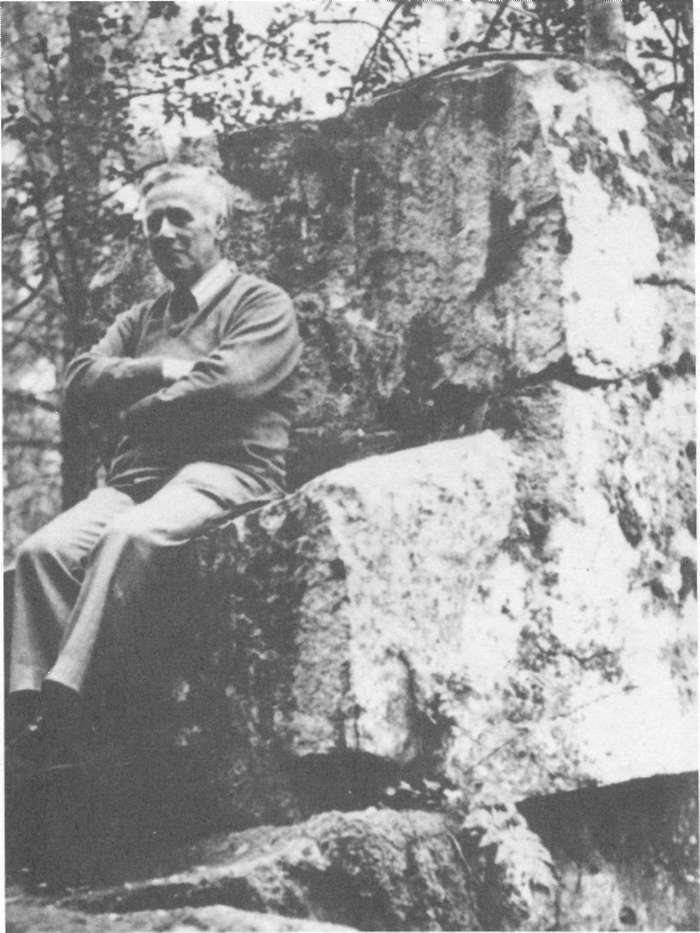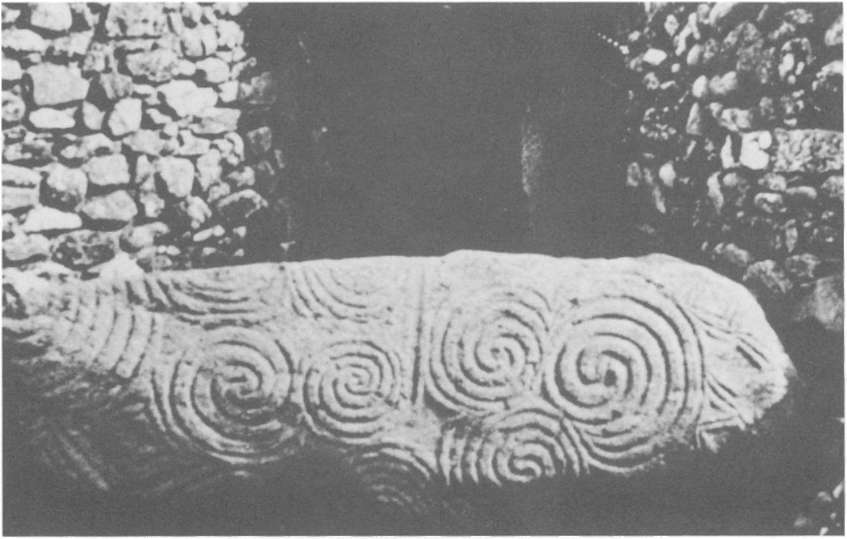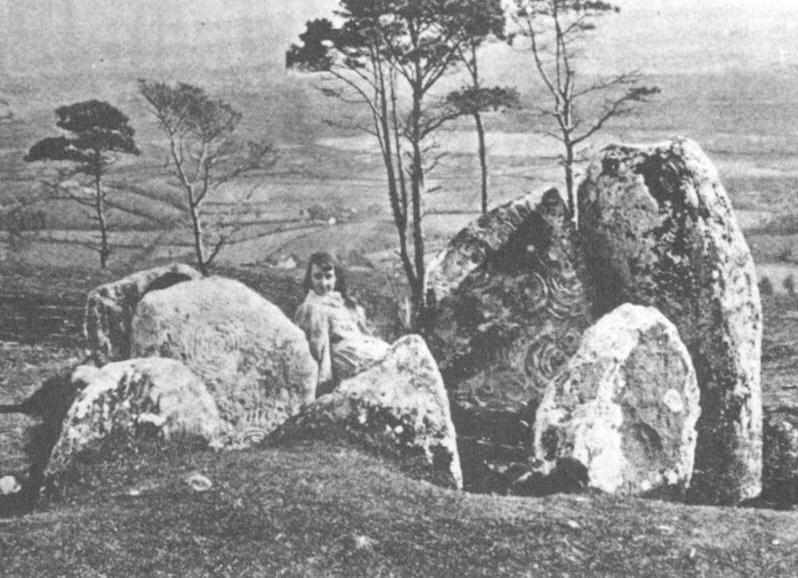 |
|
|
||
|
|
Ulsterheart Chapter 1 (Kilgreen Dawn)
pages 6 through 10
Page 6
 |
flatstone above the grave of Elizabeth Bell (d. 1821) when it was being lifted for erection in the Kerog Wall of Remembrance. He left it aside in a nearby enclosure. An hour later it was missing. Suddenly, he noticed an enthusiastic helper pitching loose rock into bedding cement for one of the Speer Memorials, including the only piece of 2000 B.C. art ever to come to light in Kerog Churchyard. He deflected the crowbar about to pulverize it, and knelt to rescue it under a hail of assurances that "there's no writin' on them stones"! These few souvenirs date from a time when bronze was coming
into use. This may give us a clue to the provenance of the hieroglyphics which adorn them. The boats that brought tin from Cornwall went farther. Irish gold ornaments have been found in Egypt, the home of hieroglyphics. But, the tiny porcelain flask found at Sess-Kilgreen, and Baltic amber-beads indicated that Kerog traded also with northern Europe.
Who were these earliest Irish people? They were Celts, but apparently not Gaelic Celts. The Gaels still lived between the Danube and the Rhine, a thousand miles by most routes from Kerog. There are two distinct types of Celt. Ethnologists classify them as Brittonic and Goidelic, or British and Gaelic.3 London was the biggest Celtic city on earth. Its name consists of two purely Celtic syllables LON-DON. And it retained its Celtic character all through the three centuries when the Roman Imperial Legions occupied Britain. It was not diluted until the Legions withdrew, leaving the country defenceless for the English to invade, and drive the Britons westward into Wales and Cornwall, and eventually the western peninsula of France to which they gave their name. Today Brittonic Celts are found in Wales, Cornwall and Brittany. Gaelic Celts are found in the Hebrides, Man, and Eire.
Professor Eoin MacNeill of University College, Dublin says "The ancient inhabitants of Britain and Ireland appear to have been known by the common name of Pretani."4 MacNeill then explains that these are the people whom Julius Caesar called Brittani, and insists that, during the Bronze Age, these Brittani were the chief people of Hibernia as well as the other island, Alba, which eventually was named after them. So Professor MacNeill shows that the ancient Greek geographers were being accurate when they referred to the two islands off western Europe, Albion and Iverna as the British Isles.
Archaeology seems to confirm MacNeill's identification. In his masterly 1974 scrutiny of their cyclopean Boyne culture, Dr. Michael Herity, Celtic Archaeologist at University College Dublin who had previously been a Radio Telefis Eireann educationalist, pinpoints their migration at about 2500 B.C. A cover-blurb condensing his three hundred page study says "In 2500 B.C. a Breton
 |
flotilla bore the builders of the passage-graves into the Irish Sea. In the Boyne Valley this dynamic society founded a thriving economy, and built three magnificent tombs each covering more than an acre."5 Moving inland, they erected three hundred tombs, siting them on the summits of the highest hills. "Later generations ornamented their monuments with an alphabet of magic symbols, combining them in abstract patterns to enhance the impact of their architecture, sometimes representing shadowy human figures, male and female." Herity ends by referring to "this remarkable people the remains of whose civilization we call The Boyne Culture." He locates their previous homeland around the Morbihan (Little Sea) in south-east Brittany. Then he traces their progress to the Ulsterheart by "their most complex cruciform style".
But literary confirmation of the identity of these early Irish people did not come until after the Hitler War. In 1940, the intellectual statesman Eamon De Valera set up the prestigious "Institute of Advanced Studies" in Dublin—perhaps to attract some of the
outstanding European scholars then in full flight from the Nuremberg Decrees. As a Senior Professor for Celtic research he appointed Thomas O'Rahilly. Six years later Dr. O'Rahilly published what Nora Chadwick the leading Celtic authority of the time, and Professor Myles Dillon, acclaimed as "his great book" on the "Early Irish". It was to be re-printed four times over the next thirty years.
At the outset, O'Rahilly clarifies that no Irish literature prior to the arrival of Patrick in 432 a.d. has survived. He then finds Christian writers, using sources long since lost, referring to the early pre-Christian Irish nation as Crutin or Critani. He says they substituted the Gaelic "C" for "B". After two thousand years of Crutin dominance, a related linguistic group came from the southern Netherlands about 450 b.c.— the BOLGI. Irish schoolboys know this second wave as the Fir Bolg (Belgae Men) and Belgae were the last British tribe to settle in the larger island Alba, and, that, centuries after they had become the second ingredient of the Irish nation.
BOLGI included people called the Erainn who eventually left their name on the smaller island, Hibernia. The Bolgi also included a people called the Ulaid whose name remains on the north of Ireland.
A third wave arrived about 300 b.c. The LAGINI were of the same stock as the earlier Crutin and Bolgi. The Lagini gave their name to the eastern kingdom of Laigini which the Normans, much later, adjusted to Leinster. The Lagini also included a people called the Domnainn who later spread to Devon and the northern half of Brittany which became known as Domnonia.
O'Rahilly says that this three-ply Irish population were Brittonic and spoke the type of Celtic still heard in western Brittany and across about half of Wales.6 Clearly Kerog was well populated more than two centuries before Christ. Traces of their domicile have endured.
On a hill-top near Sess-Kilgreen to this day you can see the remains of a once elaborate stone-paved grave. The name of the
 |
ancient Kerogite who was buried here we will never know. A few stone utensils, axe-heads, stone pendants and domestic pins made from animal bones are our only clues to the quality of his family life. But we may know his home address. A few fields away you'll find a great circular wall of earth and stones, now overgrown with grass and briers. Known as Coote's Fort, its enclosure is about thirty feet in diameter. In such ring-forts lived the early Kerog citizens.
Many of these ancient homes and corrals have been levelled, and those remaining are not conspicuous. Yet, more than one hundred have been located in the thirty miles of the Clogher Valley. It is of some significance that about half of these are within the parish of Kerog—a sort of primitive metropolis.
Locals tell us of at least five places where Forts have been levelled for agriculture—in Feddan, Lisbeg, Collembrone, Balnasagart, and Lismore or Derrymeen. Besides, some of the townlands beginning with the syllable LIS (fort) now bear no trace of the structure which gave rise to their names. To these two categories,